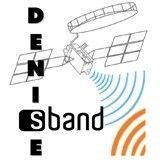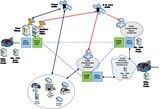
-
StatusOngoing
-
Status date2011-12-19
The DENISE project aims at designing and demonstrating, both via laboratory tests and field trials using W2A satellite, a suitable S-band interactive system capable of efficiently using the available bandwidth (15 MHz in both uplink and downlink for each of the two licensed European S-band operators) to provide:
- Interactive mobile broadcast services enhancing the DVB-SH offer,
- Messaging services for handhelds and vehicular terminals, capable of serving millions of terminals thanks to a novel optimised air-interface in the RTN link,
- Real-time emergency services such as voice and file transfer, mainly addressing institutional users on-the-move such as fire brigades, civil protections, etc.
The main objectives of the DENISE Project are:
- To define a suitable system architecture enabling efficient resource usage and support of different categories of services such interactive broadcast, mobile messaging, and bi-directional real-time communications for management of emergency situation,
- To perform a detailed design of suitable RTN link access technologies,
- To adapt DVB-SH technologiy in order to also support realtime services in the FWD link,
- To design suitable radio resource management strategies, network protocols and related signalling,
- To implement an end-to-end demonstrator,
- To validate and assess the performance of all main system functionalities in the lab,
- To demonstrate the end-to-end system capabilities through field trials with W2A satellite,
- To consolidate the system specifications based on the outcomes of field trials and lab tests.
The main challenges to be addressed by the DENISE project are the following:
- The adaptation of DVB-SH to support realtime services and the definition of a suitable return link technology allowing an efficient coexistence of the three service segments described above in terms of service differentiation, capacity usage, perceived QoS, scalability and configurability,
- The integration with terrestrial components and existing 2G/3G networks,
- The design of return complementary ground components (CGC), mainly meant to to increase scalability of the network by diminishing the use of the satellite link in congested areas, in addition to forward CGC.
The main benefits of the DENISE system can be summarised as follows:
- The coexistence of three different classes of interactive services with a DVB-SH based broadcast network,
- An outstanding level of flexibility in dynamically managing the capacity allocated to the different service classes,
- The capability to offer ubiquitous messaging services to millions of terminals per spot-beam thanks to a novel optimised access scheme in the RTN link and to the presence of return CGC,
- The support of dependable pan-European bi-directional services for emergency communications.
The high level system architecture of the DENISE system is shown in the figure below. It includes all elements that will be found in the targeted system, as well as the interfaces among them, including the interfaces to existing 2G/3G and IP terrestrial networks.It is also indicated that all elements except the NCC can appear several times in the system.
The different terminals are shown as part of the user segment; the forward and return Complementary Ground Components (also referred to as repeaters and collectors) are grouped under the complementary ground segment, which also includes the so called gap fillers (GF), which are ground elements that interact with the terminal but are not managed by the service operator.
Even if the baseline design will be done considering the features of the W2A satellite, the system shall be envisaged so as to be also compliant with potential future satellites. The ground segment is composed by the hub (or hubs) together with the NCC, both interfacing the service centres. In the targeted system, all network elements (except the satellite) can have direct interfaces to 2G/3G or IP terrestrial networks.
Figure 1: High level architecture of the DENISE communications system
The DENISE Project is organised in two phases:
- Phase 1 will address the system design and specification as well as a preliminary performance assessment by means of software simulations.
- Phase 2 will address the implementation of an end-to-end demonstrator, the design of all related algorithms, the execution of lab tests and field trials and the consolidation of the system specifications.
The project started in Autumn 2009. The Critical Design Review of Phase 1 took place in June 2010. Phase 1 was successfully concluded in November 2010. Though Phase 2 is currently on hold, the outcomes of Phase 1 have been standardised within ETSI MSS as TS 102 721: version 1.1.1 has been published in December 2011 and is available for download through the ETSI portal.







